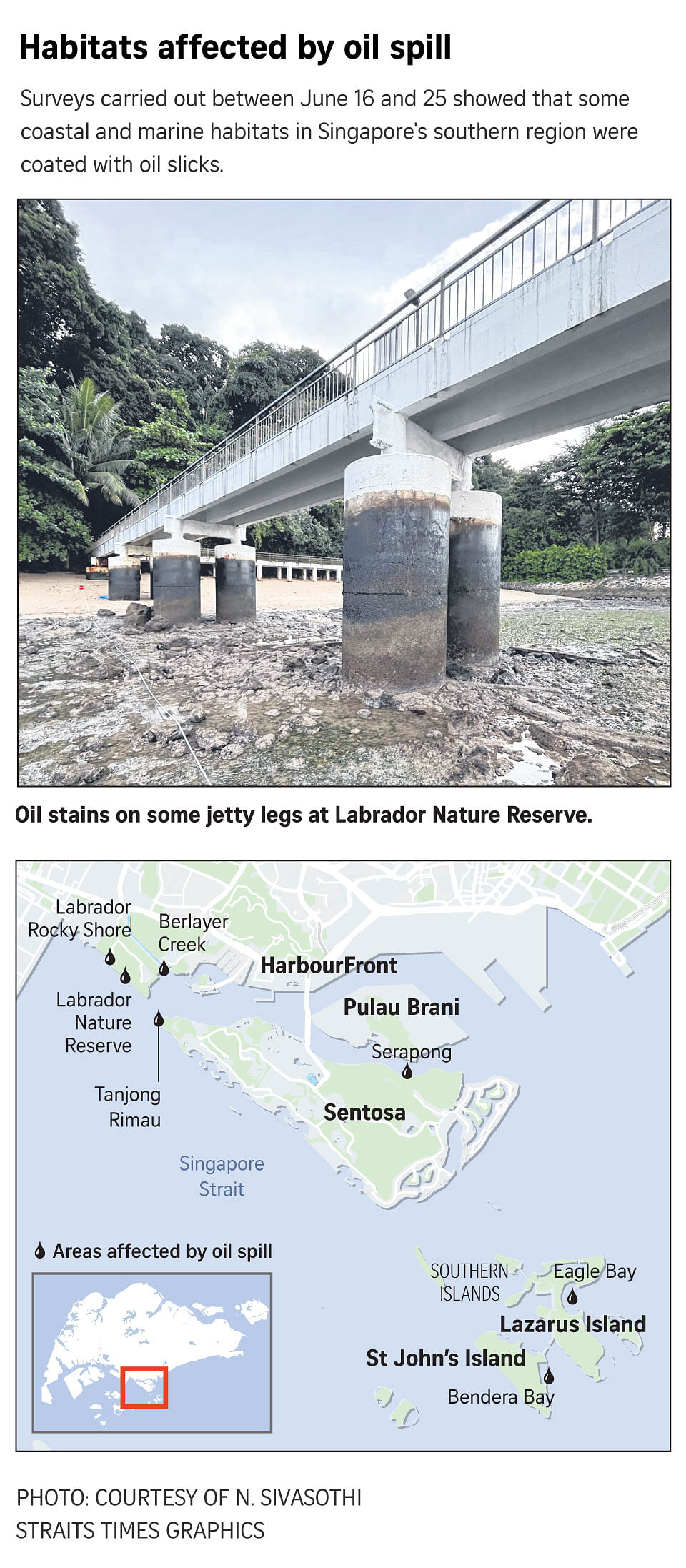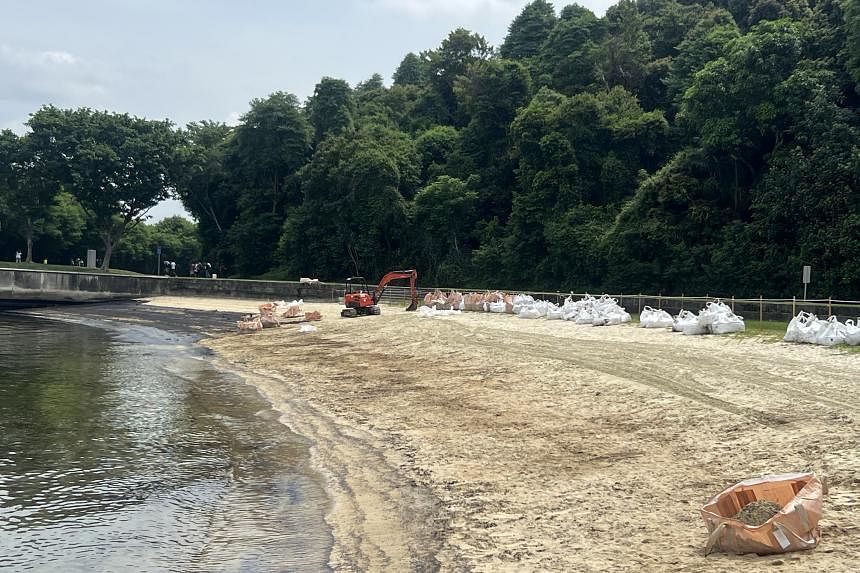ASEAN HEADLINE: Sensitive habitats in Labrador, on Sentosa and Southern Islands affected by oil slicks: Desmond Lee
.,
SINGAPORE – Oil slicks were spotted at sensitive habitats in Labrador Nature Reserve, on Sentosa and parts of the Southern Islands in the week after the Pasir Panjang oil spill incident, Minister for National Development Desmond Lee told Parliament on July 2.
The areas affected are the rare rocky shore at Labrador Nature Reserve, Sentosa’s Tanjong Rimau and Serapong, and two lagoons on St John’s and Lazarus islands – Bendera Bay and Eagle Bay.
Oil was sighted along the upper intertidal zones of those areas, which are exposed during low tide.
The outer mangrove fringes at the mouth of Berlayer Creek near Labrador Nature Reserve also had oil slicks.
The findings were based on surveys conducted between June 16 and June 25 by the authorities, scientists and the marine community in the southern habitats of Singapore.
While no significant impact on marine biodiversity and wildlife has been seen so far from the oil spill, the situation remains dynamic and there could be longer-term implications on these habitats, noted Mr Lee.
“Some of the impact on our marine and coastal ecosystems may show up only weeks or even months later, such as during spawning periods. Assessments of the environmental impact of the oil spill on our offshore islands are also still ongoing,” he added.
The intertidal zones at other biodiversity-sensitive areas appear to be largely unaffected, Mr Lee said. These places include Sisters’ Islands Marine Park, Changi Beach Park, Pasir Ris Park, Chek Jawa Wetlands on Pulau Ubin, and the mangroves at West Coast Park and Pasir Ris Park.
Several MPs had asked about the oil spill’s impacts on Singapore’s marine biodiversity.
On June 14, a Netherlands-flagged dredging boat hit a stationary Singapore-flagged bunker vessel at Pasir Panjang Terminal, causing 400 tonnes of oil to leak into the sea. It was the largest oil spill in Singapore in over a decade.
The oil spill also coincided with coral bleaching in the shallow waters of Singapore. As at early June, about 40 per cent of reefs in the shallow waters of the Southern Islands had turned white and weak.
Mr N. Sivasothi, a senior lecturer at the National University of Singapore (NUS) who surveyed Labrador Nature Reserve on June 25, said the lower parts of the reserve’s rocky shore were not smothered by the oil slick as the area was submerged during higher tides on June 14.
“The higher shore would have been affected… Long-term bio-toxicity of affected habitats and organisms can’t be determined immediately. That will take time,” he added.
NUS marine biologist Huang Danwei said less than 5 per cent of the rocky area at the higher shore was coated with oil. That rocky habitat is home to barnacles, the Ligia sea slater or sea cockroach, and a type of sea slug.
As for the Southern Islands, the higher tides in mid-June prevented the oil from reaching low intertidal habitats such as seagrasses and coral reefs, said Dr Jani Tanzil, facility director of St John’s Island National Marine Laboratory.
“In terms of the remaining oil on these higher intertidal habitats, it will re-mobilise and can affect lower intertidal habitats over time… So, the phase two cleanup is important to extract and remove as much of the contamination as possible,” she added.
With the removal of oil from the sea and oil-soaked sand from affected beaches largely completed, the more complex next phase of the cleanup is under way. This phase is expected to take around three months, and entails cleaning up oil remnants in places that are not easily accessible, such as rock bunds and breakwaters.
.

.
Mr Lee said the authorities will closely monitor the impact on and recovery of the marine habitats and biodiversity, including seagrasses, corals and aquatic life. The National Parks Board will also undertake rescue and rehabilitative efforts for affected wildlife where necessary.
He said that an action plan is being worked on to restore the sensitive habitats. This will involve coastal cleanups and beach patrols in the next six months and beyond.
Vets from Mandai Wildlife Group and the Singapore Veterinary Association, among other organisations, have offered to support wildlife rescue and rehabilitation efforts.
To plan for ecological recovery, the nature community and scientists will continue to monitor the marine biodiversity and do impact assessments.
Surveys of the Southern Islands, Labrador Nature Reserve, and Sentosa’s Serapong and Tanjong Rimau, done with the scientific community, have started, for the authorities to better understand the longer-term impacts of the oil spill on biodiversity, said Mr Lee.
Previous oil spills in 2010 and 2017 affected the intertidal and seagrass habitats in Tanah Merah and Chek Jawa, and Changi Beach Park. These past incidents have shown that while the ecosystems are resilient, they take time to recover from external stressors and oil.
“At Tanah Merah, the intertidal and seagrass habitats started to recover after one year, and no longer show any signs of impact from the 2010 oil spill today,” Mr Lee added.
Giving an update on volunteers’ roles in the cleanup efforts as at July 1, the minister said more than 700 volunteers had been mobilised to patrol East Coast Park and West Coast Park.
These volunteers came from organisations including the Public Hygiene Council and the Friends of Marine Park.
Overall, more than 1,500 individuals have signed up to help with oil-spill management efforts. An additional 2,000 have registered their interest in being kept updated on ongoing efforts and future volunteering opportunities, said Mr Lee.
He also advised members of the public to stay away from affected beaches and to report sightings of oil stains and oil-slicked wildlife, among other things.
Mr Muhammad Nasry, executive director of Singapore Youth Voices for Biodiversity, who recently surveyed a mangrove area near East Coast Park, said: “Some of the mangroves had smothered roots, with some seedlings completely covered in oil – these likely will not survive but, as microbes break down the oil, it is still possible for the habitat to recover.”
Noting that long-term monitoring is crucial, he said: “Continued study would be good for data collection to build baselines ahead of potential incidents in the future, and help reassure the public as well.”
Mr Lee said the oil spill has not impacted plans to have a second marine park at the southern part of Lazarus Island and the reef off Kusu Island.
.

@[email protected]



 Memento Maxima Digital Marketing
Memento Maxima Digital Marketing






